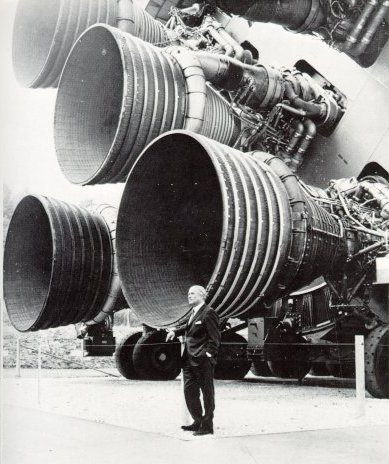
DETERMINING SATURN'S CONFIGURATION
The first launch of the Saturn booster was still five months away when, on May 25, 1961, President John F. Kennedy proposed that the United States commit itself to land a man on the Moon "in this decade". For this ambitious task a launch vehicle far more powerful than our eight-engine Saturn would be needed. To determine its exact power requirements, a selection had to be made from among three operational concepts for a manned voyage to the Moon: direct ascent, Earth orbit rendezvous (EOR), and lunar orbit rendezvous (LOR).

|
Dr. von Braun, standing
next to one of the five engines at the after end of the
Saturn V vehicle's first stage
(on display at the Alabama
Space Museum), provides a
scale reference for the humain figures shown alongside two of the rockets in
the drawing below. The sequence of launch vehicles
of ever-increasing size and
power that led from the 46-foot-high V-2 rocket through
the Mercury and Gemini
boosters to the 363-foot
Saturn V is drawn here at a single scale.
|
|
| 
| |
With direct ascent, the entire spacecraft would soft-land on the Moon carrying enough propellants to fly back to Earth. Weight and performance studies showed that this would require a launch vehicle of a lift-off thrust of 12 million pounds, furnished by eight F-1 engines. We called this hypothetical launch vehicle Nova. The EOR mode envisioned two somewhat smaller rockets that were to rendezvous in Earth orbit where their payloads would be combined. In the LOR mode a single rocket would launch a payload consisting of a separable spacecraft toward the Moon, where an onboard propulsion unit would ease it into orbit. A two-stage lunar module (LM) would then detach itself from the orbiting section and descend to the lunar surface. Its upper stage would return to the circumlunar orbit for rendezvous with the orbiting section. In a second burst of power, the propulsion unit would finally drive the reentry element with its crew out of lunar orbit and back to Earth.
As all the world knows, the LOR mode was ultimately selected. But even after its adoption, the number of F-1 engines to be used in the first stage of the Moon rocket remained unresolved for quite a while. H.H. Koelle, who ran our Project Planning Group at Marshall, had worked out detailed studies of a configuration called Saturn IV with four F-l's, and another called Saturn V with five F-l's in its first stage. Uncertainty about LM weight and about propulsion performance of the still untested F-1 and upper-stage engines, combined with a desire to leave a margin for growth, finally led us to the choice of the Saturn V configuration.

| The stack: the three-stage launch vehicle, Saturn V, surmounted by its payload, the Apollo spacecraft. The greater part of the launch vehicle consists of tankage for the fuel and for the oxidant, LOX (liquid oxygen), used in all three Saturn V stages. The powerful F-1 engines of the first stage burn kerosene to produce a combined thrust of 7.5 million pounds. The fuel for the J-2 engines of the two upper stages is liquid hydrogen. The combined thrust of the second stage's five engines is just over a million pounds, or five times that of the third stage's single J-2 engine. Development of the original hydrogen tanks was difficult because the low boiling point of hydrogen (-253 °C) required insulation sufficient to prevent transfer of heat from the outside and the comparatively warm (-183 °C) liquid oxygen. |
Saturn V, as it emerged from the studies, would consist of three stages-all brand new. The first one, burning kerosene and oxygen, would be powered by five F-1 engines. We called it S-IC. The second stage, S-11, would need about a million pounds of thrust and, if also powered by five engines, would call for the development of new 200,000-pound hydrogen-oxygen engines. A single engine of this thrust would just be right to power the third stage. The Saturn l's S-IV second stage was clearly not powerful enough to serve as the Saturn's third one. A much larger tankage and at least thirteen of Pratt & Whitney's little LR-10 engines would be required; this did not appear very attractive.
When bids for the new J-2 engine were solicited, Pratt & Whitney with its ample liquid-hydrogen experience was a strong contender. But when all the points in the sternly controlled bidding procedure were counted, North American's Rocketdyne Division won again.
North American had been involved in the development of liquid fuel rocket engines since the immediate postwar years and the Navajo long range ramjet program. The engines it developed for the Navajo booster and their offspring later found their way into the Atlas, Redstone, Thor, and Jupiter programs. For the testing of these engines NAA's Rocketdyne Division had acquired a boulder-strewn area high in the Santa Susana mountains, north of Los Angeles, that had previously served as rugged background for many a Western movie. The Santa Susana facility would henceforth serve not only for the development of the new J-2 engine, but also for short duration "battleship" testing of the five-engine cluster of these engines powering the S-11 stage. (Safety and noise considerations ruled out the use of Santa Susana for the 1.5-million-pound-thrust F-1 engine. Test stands for its development were therefore set up in the Mojave desert, adjacent to Edwards Air Force Base.)
| Next |